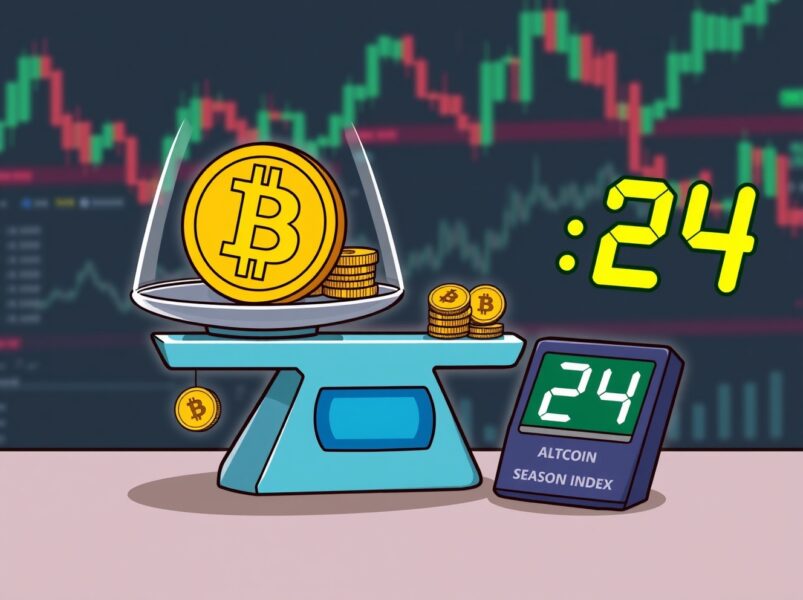Altcoin Season Index Stalled at 24: What This Crucial Metric Means for Your Portfolio
BitcoinWorld Altcoin Season Index Stalled at 24: What This Crucial Metric Means for Your Portfolio The cryptocurrency market is a dynamic beast, constantly shifting between periods of Bitcoin dominance and bursts of altcoin growth. Right now, a key indicator, the Altcoin Season Index, is telling a clear story: it remains stalled at 24. This figure, provided by CoinMarketCap, isn’t just a random number; it offers crucial insights into which segment of the market is currently leading the charge. For any crypto investor, understanding this index is vital for navigating market cycles. What Exactly is the Altcoin Season Index and How is it Calculated? Understanding the Altcoin Season Index is fundamental for any crypto enthusiast. It’s a straightforward yet powerful tool designed to gauge the performance of altcoins against Bitcoin over a specific period. This index helps you identify whether altcoins are broadly outperforming Bitcoin or vice versa. The Core Metric: The index specifically tracks the performance of the top 100 cryptocurrencies by market capitalization. Exclusions: To ensure accuracy, stablecoins (like USDT or USDC) and wrapped coins (like wBTC) are excluded from this calculation. This prevents their price stability or direct BTC correlation from skewing the results. Timeframe: The comparison is made over the last 90 days, providing a relevant snapshot of recent market trends. The Threshold: An “altcoin season” is officially declared when a significant majority – specifically, 75% of these top 100 altcoins – manage to outperform Bitcoin during that 90-day window. A score closer to 100 on the Altcoin Season Index indicates a robust altcoin season, where a wide array of alternative cryptocurrencies are seeing strong gains relative to Bitcoin. Conversely, a lower score, like our current 24, signals a “Bitcoin season,” meaning Bitcoin is largely outperforming the broader altcoin market. Why is the Altcoin Season Index Stalled at 24, Signaling a Bitcoin Season? The current reading of 24 on the Altcoin Season Index suggests that less than 75% of the top altcoins are outperforming Bitcoin. This isn’t necessarily a cause for alarm, but rather a reflection of prevailing market sentiment and capital flows. It highlights Bitcoin’s foundational role in the crypto ecosystem. Several factors often contribute to a “Bitcoin season”: Bitcoin’s Halving Cycle: Historically, periods leading up to and immediately following Bitcoin halvings can see renewed interest and capital flowing into BTC. Macroeconomic Uncertainty: In times of global economic instability, investors often seek refuge in perceived safer assets. Within crypto, Bitcoin is frequently viewed as the primary “store of value,” leading to increased demand. Dominance Cycle: The crypto market often moves in cycles where Bitcoin gains dominance, then altcoins catch up, and the cycle repeats. We might simply be in a phase where Bitcoin is consolidating its position. Lack of Strong Altcoin Narratives: Sometimes, the altcoin market lacks a compelling new narrative or breakthrough technology to attract significant capital away from Bitcoin. When the Altcoin Season Index is low, it means that while some altcoins might be performing well individually, the majority are struggling to keep pace with Bitcoin’s momentum. This emphasizes the need for careful selection if you’re venturing into altcoins during such a period. Navigating the Current Crypto Climate: Tips for Savvy Investors A low Altcoin Season Index doesn’t mean you should abandon altcoins entirely. Instead, it calls for a more strategic approach to your crypto portfolio. Being informed and adaptable is key. Here are some actionable insights to consider: Prioritize Research: In a Bitcoin-dominated market, identifying altcoins with strong fundamentals, clear utility, and active development becomes even more critical. “Low cap gems” can still emerge, but they require diligent research. Consider Bitcoin as a Core Holding: If the index suggests a Bitcoin season, strengthening your Bitcoin position might be a prudent move. It often acts as a barometer for the broader market’s health. Diversify Wisely: While altcoins may be underperforming generally, a diversified portfolio can help mitigate risk. Avoid overexposure to a single altcoin, especially those without a proven track record or strong community support. Risk Management: Implement strict risk management strategies, such as setting stop-losses or taking profits at predefined levels. Market volatility can be amplified for altcoins during a Bitcoin season. Monitor Market Sentiment: Keep an eye on overall market sentiment, news, and technical indicators. These can provide early clues about potential shifts in the Altcoin Season Index. Understanding the signals, like the current Altcoin Season Index, empowers you to make better decisions and position yourself advantageously in the ever-changing crypto landscape. Looking Ahead: When Might the Altcoin Season Index Shift? The crypto market is cyclical, and the current Bitcoin season indicated by the Altcoin Season Index at 24 will not last forever. Several potential triggers could signal a shift back towards altcoin outperformance, bringing exciting new opportunities for investors. Bitcoin Price Consolidation: Often, after a strong run, Bitcoin will consolidate its gains. This period can allow capital to flow into altcoins, especially those that have been lagging, as investors seek higher returns. Emergence of New Narratives: Breakthroughs in specific sectors like DeFi, NFTs, AI, or Layer 2 solutions can ignite interest and investment in related altcoins. A compelling new narrative can quickly shift the Altcoin Season Index. Reduced Bitcoin Dominance: As Bitcoin’s dominance (its market cap percentage of the total crypto market) begins to wane, it often creates room for altcoins to gain ground, indicating a broader market rally. Improved Macroeconomic Conditions: A more stable global economic outlook can encourage investors to take on more risk, potentially increasing their exposure to higher-beta assets like altcoins. Keeping a close watch on these macro and micro indicators will be essential for anticipating when the Altcoin Season Index might start to climb towards that coveted 75% mark, heralding a true altcoin season. In conclusion, the Altcoin Season Index at 24 serves as a vital snapshot of the current crypto landscape, clearly indicating a Bitcoin-dominated market. While altcoin seasons are exciting, understanding and navigating a Bitcoin season is equally important for strategic investment. By focusing on fundamentals, managing risk, and staying informed, investors can position themselves effectively for whatever the dynamic crypto market brings next. Remember, every season offers unique opportunities. Frequently Asked Questions (FAQs) Q1: What does an Altcoin Season Index of 24 signify? An Altcoin Season Index of 24 indicates that only 24% of the top 100 altcoins (excluding stablecoins and wrapped coins) have outperformed Bitcoin over the last 90 days. This suggests we are currently in a “Bitcoin season,” where Bitcoin is generally performing better than the broader altcoin market. Q2: How is an “altcoin season” officially defined by the index? An altcoin season is officially declared when 75% or more of the top 100 altcoins outperform Bitcoin during the 90-day measurement period. A score closer to 100 means a stronger altcoin season. Q3: Should I avoid altcoins when the Altcoin Season Index is low? Not necessarily. A low Altcoin Season Index means the majority of altcoins are underperforming Bitcoin, but individual altcoins with strong fundamentals or unique narratives can still perform well. It emphasizes the need for thorough research and careful risk management. Q4: What factors could cause the Altcoin Season Index to rise? The Altcoin Season Index could rise if Bitcoin consolidates after a strong rally, allowing capital to flow into altcoins. The emergence of compelling new narratives (e.g., in DeFi, AI, or gaming), reduced Bitcoin dominance, or improved macroeconomic conditions could also trigger a shift. Q5: Where can I find the current Altcoin Season Index? The Altcoin Season Index is typically provided by platforms like CoinMarketCap, which calculates and displays this metric based on their methodology. Share Your Thoughts and Stay Connected! Did this analysis of the Altcoin Season Index provide valuable insights for your crypto journey? We’d love to hear your perspective! Share this article with your fellow crypto enthusiasts on social media and join the conversation about the current state of the market. Your engagement helps us continue to deliver timely and relevant content. To learn more about the latest crypto market trends, explore our article on key developments shaping Bitcoin price action. This post Altcoin Season Index Stalled at 24: What This Crucial Metric Means for Your Portfolio first appeared on BitcoinWorld.



